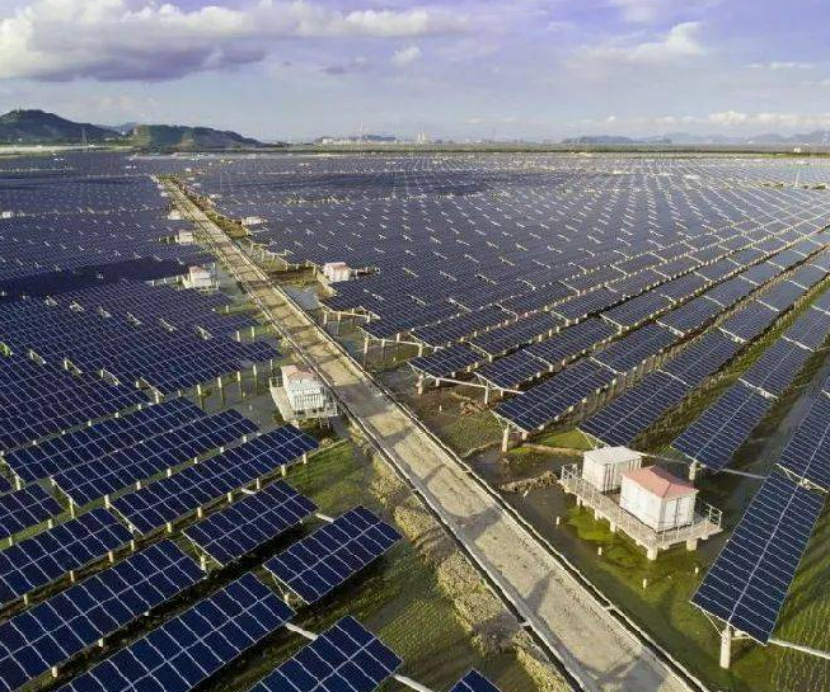Recently, new energy sources such as photovoltaics and wind power have welcomed the benefits released by the Central Committee of the Communist Party of China and the State Council.
The Central Committee of the Communist Party of China and the State Council recently issued the "Outline for Building a Powerful Country with Quality" (hereinafter referred to as the "Outline"). Key words such as "green" and "low carbon" appear frequently in the "Outline", reflecting that the implementation of the "double carbon" goal runs through all fields.
The "Outline" emphasizes the establishment of a green orientation for quality development. Carry out actions to improve the resource efficiency of key industries and key products, accelerate the research on key core technologies of low-carbon, zero-carbon and negative-carbon, and promote the low-carbon transformation of high energy-consuming industries. Comprehensively promote green design, green manufacturing, and green construction, improve unified green product standards, certification, and labeling systems, and vigorously develop green supply chains. Optimize technical standards for resource recycling to achieve green and efficient resource reuse. Establish and improve the carbon peak and carbon neutral standard measurement system, and promote the establishment of internationally recognized carbon measurement base standards, carbon monitoring and effect evaluation mechanisms. Establish and implement a standard system for land space ecological restoration. Establish a green product consumption promotion system to promote green lifestyles.
The "Outline" also pointed out that vigorously develop green buildings, further promote the application of renewable energy and resource buildings, and realize low-carbon environmental protection, energy conservation and emission reduction in the whole process of engineering construction.
The central government sets the tone for new energy
This is not the first time keywords such as new energy, renewable energy, and double carbon have appeared in the action program of the CPC Central Committee and the State Council. On December 19-21, 2022, the 2023 Central Economic Work Conference will be held in Beijing. The meeting mentioned accelerating the planning and construction of new energy systems, pumped storage, electrified energy storage, etc., and finalized the tone for the development of new energy in 2023.
The meeting called for government investment and policy incentives to effectively drive social investment and accelerate the implementation of major projects during the 14th Five-Year Plan. Accelerate the planning and construction of a new energy system, accelerate the research and development, application and promotion of cutting-edge technologies such as new energy, and seize new opportunities in the process of adjusting the global industrial structure and layout. The relevant fiscal and financial policies proposed by the Central Economic Work Conference have accelerated the implementation of large-scale ground power station projects. The construction of a new energy system will play a positive role in promoting the upgrading of pumped storage, electrochemical energy storage, UHV line transmission and power system.
General Secretary Xi Jinping pointed out: "Promoting the development of new energy and clean energy should be placed in a more prominent position, and light energy, silicon energy, hydrogen energy, and renewable energy should be actively and orderly developed." On December 9, 2022, Vice Premier Han Zheng of the State Council stated that promoting the development of new energy and clean energy should be placed in a more prominent position.
The report of the 20th National Congress of the Communist Party of China proposes to actively and steadily promote carbon peaking and carbon neutrality. Achieving carbon neutrality is a broad and profound economic and social systemic change. Based on our country's endowment of energy resources, we must insist on building first and then destroying it, and implement the carbon peak action in a planned and step-by-step manner. Improve the regulation of total energy consumption and intensity, focus on controlling fossil energy consumption, and gradually shift to a "dual control" system for total and intensity of carbon emissions. Promote clean, low-carbon and efficient use of energy, and promote clean and low-carbon transformation in the fields of industry, construction, and transportation. Deeply promote the energy revolution, strengthen the clean and efficient utilization of coal, increase the exploration and development of oil and gas resources and increase reserves and production, accelerate the planning and construction of new energy systems, coordinate hydropower development and ecological protection, actively and safely develop nuclear power in an orderly manner, and strengthen energy production, supply and storage sales system construction to ensure energy security. Improve the carbon emission statistics and accounting system, and improve the carbon emission rights market trading system. Improve the carbon sink capacity of the ecosystem. Actively participate in the global governance of climate change.

Under the dual-carbon strategy, photovoltaics will become the protagonist
The National Development and Reform Commission and the National Energy Administration have also repeatedly stated that the construction of large-scale wind and solar bases is the top priority for the development of new energy during the "14th Five-Year Plan". The National Development and Reform Commission has issued the first batch (97GW) and the second batch (450GW) of a total of 547GW of wind and solar base construction indicators, and the third batch of large-scale wind power and photovoltaic base indicators is also expected to be issued in 2023.
Jin Zhuanglong, Minister of Industry and Information Technology, said in an interview with the media that it is necessary to consolidate the leading position of advantageous industries. Strengthen the new energy automobile industry, comprehensively enhance the competitiveness of the photovoltaic industry and promote the high-quality development of the shipbuilding industry.
On February 4, 2023, the launching ceremony of the National Green Exchange was held in Beijing. At the ceremony, Yi Gang, Deputy Secretary of the Party Committee and Governor of the People's Bank of China, said: In 2021, the People's Bank of China will launch carbon emission reduction support tools, which will provide support for the three fields of clean energy, energy conservation and environmental protection, and carbon emission reduction technologies in accordance with market-oriented principles. Businesses are offered loans at a prime rate of 1.75%. At present, carbon emission reduction support tools have issued more than 300 billion yuan in re-loans, and supported commercial banks in issuing carbon emission reduction loans of more than 510 billion yuan. In 2022, they will reduce carbon emissions by more than 100 million tons of carbon dioxide equivalent.
In response to the national "dual carbon" strategy, China Huaneng, China Energy Group, China Huadian, State Power Investment Corporation, and China Datang, the five major power generation companies, the six small giants, and local state-owned enterprises are increasing investment in new energy industries. On February 7th, China Huaneng held the 2023 New Energy Construction Promotion Conference, prior to arranging 20 million kilowatts of new energy projects to realize physical start-up and construction preparations, and to start more than 30 million kilowatts of new energy projects throughout the year.
The National Energy Administration stated at the 2023 Energy Work Conference that by 2023, the installed capacity of wind power will reach about 430 million kilowatts, and the installed capacity of solar power will reach about 490 million kilowatts. The cumulative installed capacity of the two reached 920 million kilowatts, of which the newly installed capacity will reach 160 million kilowatts, a year-on-year increase of over 33%.
By the end of 2022, my country's installed wind power capacity will be 370 million kilowatts, and photovoltaic installed capacity will be 390 million kilowatts. This means that in 2023, the target for newly installed wind power capacity is 60 million kilowatts (60 GW), and the target for newly installed photovoltaic capacity is 100 million kilowatts (100 GW).
According to the power industry statistics released by the National Energy Administration, in 2022, my country's newly installed photovoltaic capacity will be 87.41 million kilowatts. Although this data differs from the National Energy Administration's disclosure on CCTV in June 2022 that 121GW of photovoltaic projects are under construction, there is a certain gap between the expected grid-connected target of 108GW. However, as we all know, the installed capacity of photovoltaics in 2022 will be lower than expected, mainly due to the tight supply balance leading to price increases in the entire industry chain, and a number of projects being delayed in construction. By the end of 2022, the tight balance of supply in the market has eased, and it is expected that the demand for installed capacity will rebound strongly.
At present, the market generally predicts that 2023 will be the most prosperous year for photovoltaics, with global new installed capacity reaching 250-350 GW and domestic new installed capacity exceeding 100 GW. Soochow Securities predicts that in 2023, the newly installed domestic photovoltaic capacity will reach 140 GW.
Ren Zeping, a well-known economist, has published many times in support of new energy. He said, "Not buying new energy now is like not buying a house 20 years ago." New energy-related industries are the most promising and explosive fields for China's economy in the future.
Liu Hanyuan, chairman of the board of directors of Tongwei Group, said that carbon neutrality is the greatest transformation of mankind in the next 20 to 30 years or even longer. There is no one, it is the only one!
He believes that photovoltaic power generation resources are sufficient and the conversion efficiency is relatively high, which will account for 60 to 70% or even higher of future renewable energy sources and become the leading role in future renewable energy.

 Building 1, No 268 Furong Road, Economic Development District , Hefei city, Anhui
Building 1, No 268 Furong Road, Economic Development District , Hefei city, Anhui 17718186027
17718186027 0551-68891338
0551-68891338 info@baufar.com
info@baufar.com


